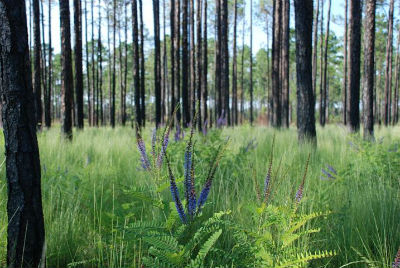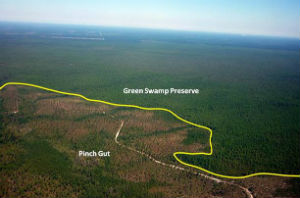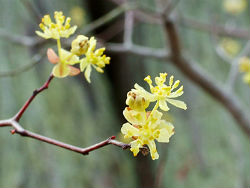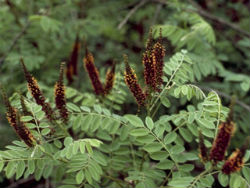 Maintaining the longleaf pine forest is one of the restoration goals at Pinch Gut Ridge. Photo: The Nature Conservancy |
SUPPLY — Hundreds of acres of longleaf pine forest in Brunswick County have been spared from potential development thanks to the on-going efforts of The Nature Conservancy.
The global conservation organization recently announced its acquisition of 454 acres in the Pinch Gut Ridge, an area environmentalists say is crucial in maintaining the Green Swamp Preserve. The preserve, famous for its carnivorous plants and orchids, spans more than 17,000 acres just north of Supply on N.C. 211.
Supporter Spotlight
This latest purchase marks the end of a four-year venture for the Conservancy, which has spent about $4 million collected from private donors and grants, including an Environmental Enhancement Fund grant from the state Department of Justice, to buy nearly 1,000 acres of the sandy ridge.
The Conservancy plans to transfer the land to the N.C. Wildlife Resources Commission, which owns about 1,050 acres adjacent to the Conservancy’s property.
All 2,000 or so acres, about half of which is longleaf pine habitat and the other half wetlands, will eventually be transformed into state game lands, said Dan Ryan, Southeast Coastal Plain program director in the Conservancy’s Wilmington office.
“There’s a lot of benefit for this piece of property because of the Green Swamp Preserve,” Ryan said. “Most of the Green Swamp proper is pocosin habitat. It requires fire, which we do.”
The modern method for maintaining longleaf pine forests is through controlled burns, which reduce hardwood growth and manage grasses and forbs in the understory. Fires are essential to longleaf habitats for a number of reasons, including the fact that longleaf seeds must germinate on bare ground.
Supporter Spotlight
Ensuring that the land bordering the Green Swamp Preserve remains undeveloped gives the Conservancy a defensible perimeter when conducting controlled burns to maintain the land, Ryan said.
 The dry ridge of Pinch Gut contrasts with the lushness of the Green Swamp. Photo: The Nature Conservancy |
“It’s really a great connectivity project,” he said. “There are just a lot of positives to this story, including the fact that we’ll be able to manage our lands better.”
The portion of the dry, sandy ridge the Conservancy owns rests along the southeastern edge of the Green Swamp nature preserve. The land was last burned about 10 years ago and the Conservancy plans to burn upwards of 500 acres of it in conjunction with the state this month, he said.
The land was once owned by International Paper and eyed by developers during the height of the building boom in Brunswick County in 2005-06. The paper company eventually sold the land to a timber company, but not before planting longleaf pines on about 500 of the 2,000 acres.
Efforts to restore longleaf habitat began years ago with the realization that longleaf forests had been overexploited for more than a century.
By the early 1990s only about 2.8 million acres of longleaf pine forests remained in the southeastern United States, according to The Longleaf Alliance. That’s a massive reduction from the estimated 90 million acres that once thrived from Virginia south.
The alliance reports that longleaf forests today have increased to about 3.2 million acres.
In addition to its longleaf habitat, Pinch Gut Ridge is a biologically rich area that is home to a number of rare plants, including the savanna indigo bush, which is a state threatened species, the Venus flytrap and pondspice.
 Pinch Gut is biologically rich and is home to a number of rare plants, like the pondspice. Photo: Virginia Winn, S.C. Association of Naturalists |
 The savannah indigo bush, a threatened species in the state, is also found at Pinch Gut. Photo: Paul Cox, Lady Bird Johnson Wildflower Center |
The ridge is also part of the headwaters to the Lockwood Folly River, which is undergoing restoration efforts by local residents, the N.C. Coastal Federation and the Brunswick County Soil and Water Conservation District. Polluted runoff has forced the closure of portions of the river to shellfishing throughout the years.
The federation, which conducted a two-year study on the river’s pollution problems, has joined in efforts with the county to restore shellfish beds in the river.
“Plans are to restore the rest of it within the next five to 10 years,” Ryan said. “Once we convey our ownership to the Wildlife Resources Commission they’ll do the restoration in concert.”
It will take about a year to transfer the property to the state.
During that time, wildlife officials will have to determine what may be hunted on the new game land, which abuts a black bear sanctuary.
“Sanctuaries are important to bears,” said Tommy Hughes, the state Wildlife Resources Commission’s Coastal Eco Region supervisor. “Bears get big and old on sanctuaries. At the same time, if we get a lot of development, having means where we can control that bear population is going to be important. All of that will be factored in when we evaluate the land. Nothing is really finalized yet.”
Once the commission receives the land, it won’t likely be open to the public until the 2014-15 hunting season, he said. The commission’s goal, Hughes said, is to manage and restore former longleaf sites.
“We’ll be prescribed burning,” he said. “That’s the most important thing for that longleaf. We’re slowly bringing fire into the landscape.”








